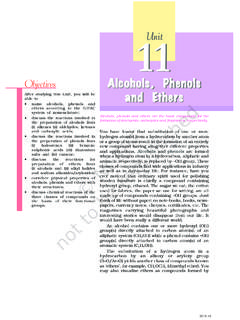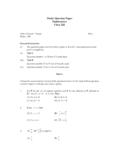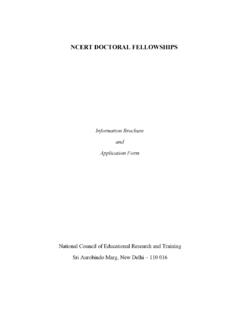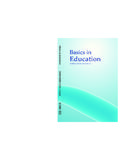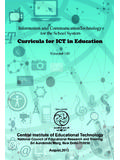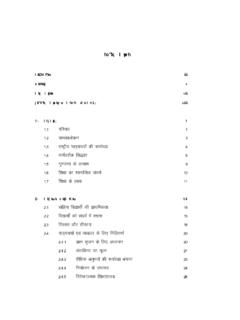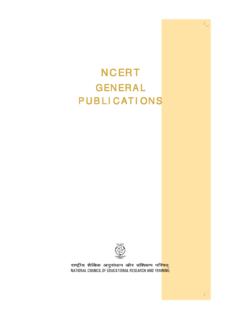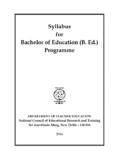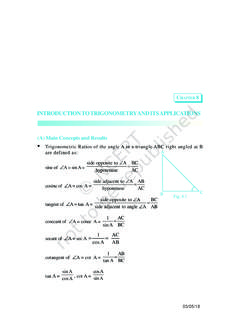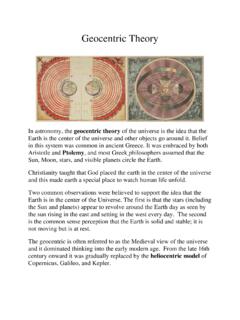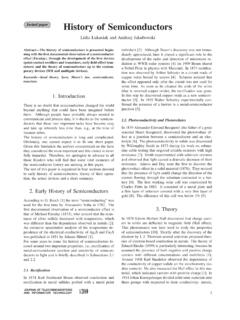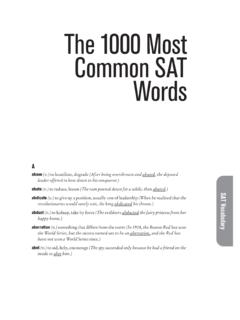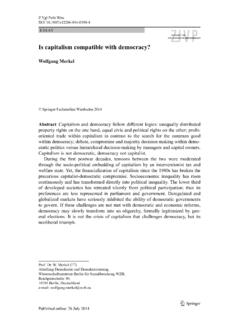Transcription of The Making of a Scientist
1 READ AND FIND OUT How did a book become a turning point in RichardEbright s life? How did his mother help him?AT the age of twenty-two, a former scout of the year excited the scientificworld with a new theory on how cells work. Richard H. Ebright and hiscollege room-mate explained the theory in an article in the Proceedingsof the National Academy of was the first time this important scientific journal had everpublished the work of college students. In sports, that would be likemaking the big leagues at the age of fifteen and hitting a home runyour first time at bat*. For Richard Ebright, it was the first in a longstring of achievements in science and other fields. And it all startedwith only child, Ebright grew up north of Reading, Pennsylvania. There wasn t much I could do there, he said. I certainly couldn tplay football or baseball with a team of one. But there was one thing Icould do collect things.
2 So he did, and did he ever! Beginning in kindergarten, Ebrightcollected butterflies with the same determination that has marked allhis activities. He also collected rocks, fossils, and coins. He becamean eager astronomer, too, sometimes star-gazing all night.* A home run in the game of baseball is when the batter scores a run after running safelyaround all bases and back to the home plate without stopping. A ball hit out of the playingfield is also called a home run. Getting a paper published at the age of fifteen in a scientificjournal is here compared to scoring a home run while batting for the first Ebright has recieved the SearleScholar Award and the Schering PloughAward for Biochemistry and MolecularBiology. It was his fascination for butterfliesthat opened the world of science to Making of a Scientist62021 22 From the first he had a driving curiosity along with a bright also had a mother who encouraged his interest in learning.
3 Shetook him on trips, bought him telescopes, microscopes, cameras,mounting materials, and other equipment and helped him in manyother ways. I was his only companion until he started school, his mothersaid. After that I would bring home friends for him. But at night wejust did things together. Richie was my whole life after his father diedwhen Richie was in third grade. She and her son spent almost every evening at the dining roomtable. If he didn t have things to do, I found work for him notphysical work, but learning things, his mother said. He liked wanted to learn. And learn he did. He earned top grades in school. On everydaythings he was just like every other kid, his mother the time he was in the second grade, Ebright had collected all twenty-five species of butterflies found around his hometown. (See following box.)Species and Sub-species of Butterflies Collected inSix Weeks in Reading, PennsylvaniaWood Nymphsand Satyrs eyed brown wood nymph (grayling)Monarchs monarch or milkweedWhites and Sulphurs olympia cloudless sulphur European cabbageGossamer-WingedButterflies white M hairstreak acadian hairstreak bronze copper bog copper purplish copper eastern-tailed blue melissa blue silvery blueSnout ButterflyBrush-footedButterflies variegated fritillary Harris s checkerspot pearl crescent mourning cloak painted lady buckeye viceroy white admiral red-spotted purple hackberry That probably would have been the end of my butterfly collecting, he said.
4 But then my mother got me a children s book called TheTravels of Monarch X. That book, which told how monarch butterfliesmigrate to Central America, opened the world of science to the eageryoung Making of a Scientist332021 22 Footprints without Feet34At the end of the book, readers were invited to help study butterflymigrations. They were asked to tag butterflies for research by DrFrederick A. Urquhart of the University of Toronto, Canada. Ebright smother wrote to Dr Urquhart, and soon Ebright was attaching lightadhesive tags to the wings of monarchs. Anyone who found a taggedbutterfly was asked to send the tag to Dr butterfly collecting season around Reading lasts six weeks inlate summer. (See graph below.) If you re going to chase them one byone, you won t catch very many. So the next step for Ebright was toraise a flock of butterflies. He would catch a female monarch, take hereggs, and raise them in his basement through their life cycle, from eggto caterpillar to pupa to adult butterfly.
5 Then he would tag the butterflies wings and let them go. For several years his basement was home tothousands of monarchs in different stages of and Kinds of ButterfliesCollected in Six Weeks Eventually I began to lose interest in tagging butterflies. It s tediousand there s not much feedback, Ebright said. In all the time I did it, he laughed, only two butterflies I had tagged were recaptured andthey were not more than seventy-five miles from where I lived. READ AND FIND OUT What lesson does Ebright learn when he does not winanything at a science fair? What experiments and projects does he then undertake? What are the qualities that go into the Making of a Scientist ?0123456 78910 Gossamer-WingedWood Nymphs and SatyrsBrush-FootedWhites and SulphursMonarchSnoutKindsNumber Collected2021 22 The Making of a Scientist35 Then in the seventh grade he got a hint of what real science iswhen he entered a county science fair and lost.
6 It was really a sadfeeling to sit there and not get anything while everybody else had wonsomething, Ebright said. His entry was slides of frog tissues, whichhe showed under a microscope. He realised the winners had tried todo real experiments, not simply make a neat the competitive spirit that drives Richard Ebright wasappearing. I knew that for the next year s fair I would have to do a realexperiment, he said. The subject I knew most about was the insectwork I d been doing in the past several years. So he wrote to Dr Urquhart for ideas, and back came a stack ofsuggestions for experiments. Those kept Ebright busy all throughhigh school and led to prize projects in county and internationalscience his eighth grade project, Ebright tried to find the cause of aviral disease that kills nearly all monarch caterpillars every few thought the disease might be carried by a beetle.
7 He triedraising caterpillars in the presence of beetles. I didn t get any realresults, he said. But I went ahead and showed that I had tried theexperiment. This time I won. The next year his science fair project was testing the theory thatviceroy butterflies copy monarchs. The theory was that viceroys looklike monarchs because monarchs don t taste good to birds. Viceroys,on the other hand, do taste goodto birds. So the more they look likemonarchs, the less likely they areto become a bird s s project was to seewhether, in fact, birds would eatmonarchs. He found that astarling would not eat ordinarybird food. It would eat all themonarchs it could get. (Ebrightsaid later research by other peopleshowed that viceroys probably docopy the monarch.) This projectwas placed first in the zoologydivision and third overall in thecounty science is the monarch butterfly (top)different from the viceroy butterfly (bottom)?
8 2021 22 Footprints without Feet36In his second year in high school, Richard Ebright began the researchthat led to his discovery of an unknown insect hormone. lndirectly, italso led to his new theory on the life of question he tried to answer was simple: What is the purpose ofthe twelve tiny gold spots on a monarch pupa? Everyone assumed the spots were just ornamental, Ebright said. But Dr Urquhart didn t believe it. To find the answer, Ebright and another excellent science studentfirst had to build a device that showed that the spots were producing ahormone necessary for the butterfly s full project won Ebright first place in the county fair and entryinto the International Science and Engineering Fair. There he wonthird place for zoology. He also got a chance to work during thesummer at the entomology laboratory of the Walter Reed ArmyInstitute of a high school junior, Richard Ebright continued his advancedexperiments on the monarch pupa.
9 That year his project won firstplace at the International Science Fair and gave him another chanceto work in the army laboratory during the his senior year, he went a step further. He grew cells from amonarch s wing in a culture and showed that the cells would divideand develop into normal butterfly wing scales only if they were fedthe hormone from the gold spots. That project won first place forzoology at the International Fair. He spent the summer after graduationdoing further work at the army laboratory and at the laboratory of Department of following summer, after his freshman year at HarvardUniversity, Ebright went back to the laboratory of the Department ofAgriculture and did more work on the hormone from the gold the laboratory s sophisticated instruments, he was able toidentify the hormone s chemical year-and-a-half later, during his junior year, Ebright got the ideafor his new theory about cell life.
10 It came while he was looking at X-rayphotos of the chemical structure of a he saw those photos, Ebright didn t shout, Eureka! or even, I ve got it! But he believed that, along with his findings about insecthormones, the photos gave him the answer to one of biology s puzzles:how the cell can read the blueprint of its DNA. DNA is the substancein the nucleus of a cell that controls heredity. It determines the formand function of the cell. Thus DNA is the blueprint for 22 The Making of a Scientist37 Ebright and his college room-mate, James R. Wong, worked all thatnight drawing pictures and constructing plastic models of moleculesto show how it could happen. Together they later wrote the paper thatexplained the no one who knew him, Richard Ebright graduated fromHarvard with highest honours, second in his class of 1,510. Ebrightwent on to become a graduate student researcher at Harvard MedicalSchool.
